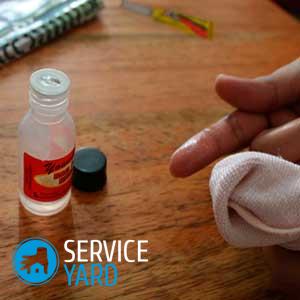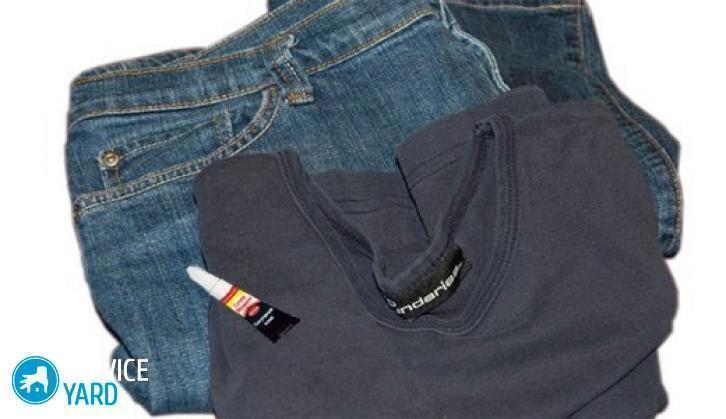Fabric Adhesive

Nowadays, many people want to somehow refresh the interior of the house or at work, to introduce some new elements into the clothes. Maybe you need to seal a hole on clothes, bag, upholstered furniture. For this, various types of fabrics are used, so the question arises of which fabric glue is more suitable. After reading our article, you can quickly make a choice.
to contents ↑Adhesive for fabric - principles of choice
In order to glue the material qualitatively, you need to choose the right glue. When the solution is selected according to the fabric and characteristics, the product will last a long time and will not change its appearance.
Cloth glue can be divided according to the following main characteristics:
- composition and basic properties;
- heat resistance;
- moisture resistance;
- appointment;
- application requirements.
to contents ↑Important! Transparent fabric glue is suitable for bonding parts on a fabric basis. It has several advantages:
- resistant to temperature extremes and the influence of sunlight;
- moisture resistant;
- safe for human health.
Types of composition
The composition of the adhesive for fabrics can be divided into such varieties:
- polyurethane - due to the fact that it has a synthetic base, it glues all types of fabric, leather and other materials qualitatively, the seam is very elastic and durable;
- neoprene - durable and resistant to high temperatures;
- styrene butadiene - when using it, we get a high-quality elastic seam, one of the disadvantages is that they are not sold in stores and are used only in production;
- nitrocellulose - glues tissue to the skin with quality;
- perchlorovinyl - suitable for bonding different types of fabrics;
- rubber - has high elasticity;
- hot melt - used for gluing rhinestones, beads and other decorations;
- PVA glue for fabric - very versatile.
Do-it-yourself ways to make glue for fabrics
If you like to experiment, do it yourself, with our help you can prepare glue for gluing fabric at home.
Method 1 - preparing PVA glue
To prepare this glue, you will need the following ingredients:
- distilled water - 1l;
- photographic gelatin - 5 g;
- pharmacy glycerin - 4 g;
- wheat flour - 100 g;
- ethyl alcohol - 20 ml;
Cooking Instructions:
- Soak gelatin in a glass of water until completely swollen.
- Make a water bath. Place a bowl of swollen gelatin there, stirring to add flour.
- Bring the mixture to a boil, stirring constantly.
- Then, while continuing to stir, gradually add glycerin and alcohol.
- The glue is cooled and ready to use.
Method 2 - Casein
Necessary components:
- casein powder;
- water.
Order of preparation:
- Take a flat container, pour the powder - the ratio of the powder to water is 1: 2.
- Add water in a thin stream, stirring until a thick mass is obtained.
- Stir for up to 30 minutes.
Important! The resulting glue must be used within 2 hours, after - it will harden and will not be suitable for use.
Method 3 - Dextrin
To prepare this type of glue, the following ingredients will come in handy:
- starch;
- water.
- Pour starch into a wide enameled pan and put in the oven at 160C for 2 hours.
- Boil water - take water in proportion to starch 1: 1.
- Pour the prepared starch (dextrin) into a boiling water in a thin stream, stirring.
- Stir until completely dissolved.
to contents ↑Important! The resulting emulsion must be used quickly, since the adhesive for the fabric on this basis will harden.
What glue to glue the fabric?
To work with fabrics, many types of glue are suitable. After reading our recommendations, you can quickly find the brand of glue that is suitable for your work.
Examples of rubber glue items:
- Fensol 60 Fentac Adhesives - Synthetic rubber glue is available as an aerosol. You can buy at any hardware store.
- Bison Textile - made on the basis of rubber latex. It is characterized by high adhesion, heat-resistant, waterproof. well suited for repairing holes and tears on jeans and other fabrics.
Important! When working with a fabric, this type of glue gives you the opportunity to get an elastic seam, practical to use.
Examples of PVA glue:
- "Expert" PVA glue is construction - can glue the fabric in a quality manner, easy to use. Available at any hardware store.
- Glue PVA Super Brauberg - not afraid of low temperatures, dries quickly.
Examples of hot-melt adhesive brands:
Hot glue is often used in their work by needlewomen and seamstresses. It is sold in powder form and in pistol rods.
- Rexant - glue stick, dries quickly, guarantees bonding strength.
- Termoteks is a powder adhesive for leather and fabric. Used for gluing applications, hem bottom products.
Examples of names of polyurethane-based glue:
- Super NN is a budget glue for fabric, has water-repellent properties, is not afraid of temperature changes. Grasps in 10-20 minutes, full consolidation in 12 hours.
- UR-600 - durable, very high quality glues not only fabrics, but also leather, PVC, rubber, polyurethane. It is resistant not only to water, but to oils and gasoline, among the differences - economical consumption and practicality in use.
Examples of styrene-butadiene grades:
- TOP-UR-5-FR - often used in the furniture industry, for gluing felt, upholstery, leather. Glues very quickly, making the seam highly elastic.
How to glue rhinestones on the fabric?
Many of you like patterns on fabrics made from small stones - rhinestones. Following our tips, you can make an original drawing at home. Glue can be bought at stores specializing in the sale of fabrics and accessories.
Important! It is very convenient to use pistols with hotmelt.
Before you begin, prepare the following tools and materials:
- rhinestones;
- glue or gun with hot glue;
- mat;
- small tongs;
- durable paper napkins.
Important! Before starting work, practice gluing rhinestones on an unnecessary piece of fabric.
Step-by-step instruction:
- Place the drawing on the fabric, using a simple pencil, mark where to stick the rhinestones.
- Place the mat under the fabric so that it does not stick to the table.
- If the stones are large, apply glue on them, if small, then immediately on the fabric
- Use small tweezers to attach the stones.
- Periodically wipe with a cloth tweezers and glue residue on rhinestones.
Adhesive for jeans
Very often we encounter holes on our favorite jeans, especially on children’s. There are such inaccessible places in which it is very difficult to sew up, but you can also seal it.
In order not to spoil the clothes, you need to choose the right adhesive for denim.
For this work, you will need a water-repellent, heat-resistant adhesive, for example:
- “Fensol 60 Fentac Adhesives”;
- “Bison Textile”;
- "Super NN";
- “UR-600”;
- Schuh and Leder.
to contents ↑Important! On the packaging of each of the above brands of glue you will find instructions for use. Carefully study and perform all the actions according to her. Work in a room that is well ventilated, as all adhesives are toxic. Also, do not work near open flames.These glue belong to the group of flammable.
How to stick fabric to fabric?
If you want to connect two pieces of fabric without firmware, you can use any of the glue for fabric described above. How to stick fabric to fabric? And of course, there are little tricks. They will help make the connection inconspicuous:
- It is necessary to cut off the edge fringe, fit the pieces of fabric so that they fit snugly together.
- Cut the patch - a strip 2 cm wide. It is needed so that the glue does not come out on the front side.
- Moisten pad and connection with water and squeeze.
- With a brush, apply a thin layer of glue on the wrong side of the bonding material and on the pad itself. Leave for a while until it stops sticking. Then apply the second layer, also let dry.
- Fold the material, in the middle from the wrong side we lay the pad.
- Iron with a hot iron for 10 seconds. Break for 4 seconds, and repeat again until completely dry.
Spray adhesive for fabric
Also on the shelves of the store you can buy aerosol glue for the fabric.
It is very convenient to use. Main advantages:
- No need additional tools when using;
- convenient to use;
- seeps into hard-to-reach places;
- lays on complex surfaces in an even layer;
- not afraid of high temperatures;
- economical;
- residues are stored for a long time, without losing their properties;
- allows you to adjust the placement of the material for a long time.
Application Features:
- Shake the container before use.
- Spray at a distance of 30 cm.
Glue repair
Using glue, you can repair clothes and bags - both fabric and leather. BF-6 glue will come to your aid. Step-by-step instructions for using universal glue:
- Cut the patch - the size should be 1-2 cm larger than the torn area.
- Wet and wring the patch and edges of the cut.
- Squeeze the glue on the glass and let it dry (4-6 minutes).
- Apply a patch on the wrong side of the product.
- Carefully glue the edges of the cut from the inside and the contour along the overlay with glue.
- The first layer should dry, then apply the second.
- After they press the patch with a hot iron for 3-4 seconds.
- To wet a rag to put on a glued surface and to press a hot iron. Repeat 3-4 times.
to contents ↑Important! Test your glue first on an unnecessary piece of cloth, and then get to work. When using an iron, consider the temperature conditions of heating for this fabric.
Stock footage
Now you know everything you need, and even more about fabric glue. We hope you could easily decide on a more suitable option and quickly repair the product you need.
- How to choose a vacuum cleaner taking into account the characteristics of the house and coatings?
- What to look for when choosing a water delivery
- How to quickly create comfort at home - tips for housewives
- How to choose the perfect TV - useful tips
- What to look for when choosing blinds
- What should be running shoes?
- What useful things can you buy in a hardware store
- Iphone 11 pro max review
- Than iPhone is better than Android smartphones




